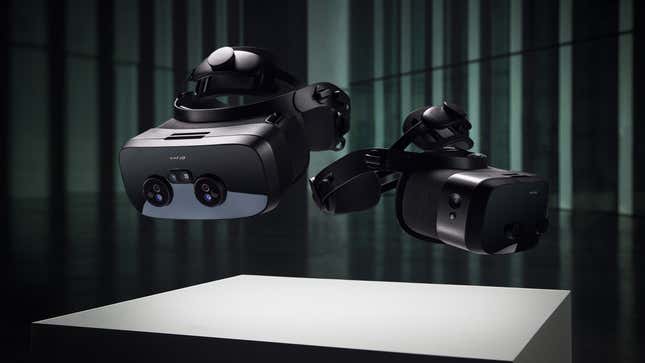
Consumer mixed-reality headsets have come a long way since the first Oculus Rift and HTC Vive, thanks to higher-resolution displays, faster refresh rates, improved motion-tracking, and more. However, enterprise-level headsets have arguably made even bigger strides, and with its new third-gen VR and XR HMDs, Varjo could be giving us regular folks a peek at the kinds of upgrades we can expect to see trickle down to consumer VR in the next couple years.
Available starting today, Varjo’s new VR-3 and XR-3 have a number of advantages over today’s best consumer headsets. First, both the VR-3 and XR-3 have a 115-degree field of view, which Varjo claims is one of the widest FOVs of any headset on the market and a significant jump up from headsets like the HP Reverb G2's FOV of 88 degrees.
On top of the that, both the VR-3 and XR-3 (which boast the same Varjo-designed custom optics) offer ultra-high resolution that uses a central focus area of 1920 x 1920 pixels per eye in addition to a peripheral focus area of 2880 x 2720 pixels per eye, which is four times the resolution you get in a Valve Index and two times the resolution of the HP Reverb G2. And in case that’s not enough, Varjo’s optics are also based on similar displays to what Samsung used on the Galaxy S10, which offer strong color reproduction that covers 99% and 93% of the sRGB and Adobe RGB spectrums. In short, Varjo’s full-frame “bionic displays” could offer possibly the best image quality of any headset available right now.
Better specs aren’t the only upgrades from the last-gen headsets, either, as both the VR-3 and XR-3 also come with a redesigned three-point precision fit headband to better accommodate a wide range of head shapes while also being 40% lighter than before, along with support for fully automatic IPD adjustment, 200Hz eye-tracking, and a new mask design that makes it easier to wipe down and sanitize between uses. Varjo also added new stereo pass-through cams so you don’t have to constantly lift up its headsets when you need to check in on meatspace.
But to me, the VR-3 and XR-3's most important upgrade (aside from optics) might be their new active cooling fans, which should prevent the headset from becoming uncomfortably moist like so many other headsets do after prolonged sessions.

Meanwhile, for businesses that need headsets that can handle both VR and XR applications, the XR-3 boasts LiDAR sensors that can use depth info to merge the real world with 3D renders.
Sadly, due to the pandemic, I haven’t had a chance to check out either of Varjo’s new headsets in person, however, based on some of the sample comparisons released by Varjo, the optics in their new headsets are quite impressive. In a screenshot from a flight simulator, the VR-3 and XR-3's increased resolution makes it possible to actually see the the instrument panel in the plane’s cockpit, which means that instead of fumbling around trying to squint at various readouts, a prospective pilot could get training that would more readily carry over to the real world. And with the Varjo’s increased FOV (which is up 40% from the company’s previous headsets), enhanced VR or XR immersion should get a huge boost too.

Finally, even though the $3,200 VR-3 and $5,500 XR-3 are still quite expensive, especially compared to your average consumer headset (and that’s not including an $800-$1,500 subscription fee), Varjo’s new headsets are around half the price of its previous headsets. Regardless, if this is the kind of optics and image quality we can look forward to in future consumer headsets, I can’t wait for this tech to trickle down and become more affordable.